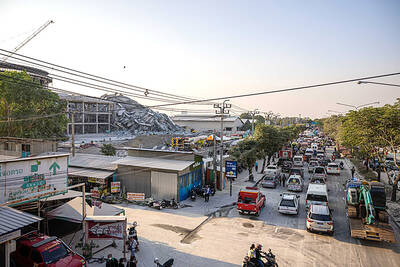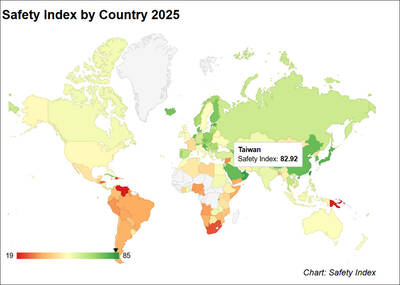China’s military is building a large military base on islands about 300km from an islet chain at the center of a territorial row with Japan — that is also claimed by Taiwan — Kyodo News reported yesterday, citing unidentified Chinese sources.
The base on the Nanji Islands in Zhejiang Province is designed to enhance China’s readiness to respond to a potential military crisis and strengthen surveillance over an air defense identification zone it declared in the area in November last year, the news agency said.
Japanese Chief Cabinet Secretary Yoshihide Suga declined to comment on the report.
The dispute over the Diaoyutai Islands (釣魚台) — known as the Senkakus in Japan — clouds ties that remain fractious even after Chinese President Xi Jinping (習近平) met Japanese Prime Minister Shinzo Abe in Beijing last month.
Encounters between Chinese and Japanese ships and planes have raised the potential for a confrontation.
Several landing strips have been paved on the main Nanji Island, Kyodo reported. The islands are about 100km closer to the disputed territory than the main island of Okinawa, which hosts about three-quarters of the US bases in Japan.
Li Jie (李傑), a senior researcher at the Chinese Naval Research Institute, said that China’s People’s Liberation Army (PLA) already has a military presence and a radar system on the islands.
“It’s a strategically important location because of its proximity to the Diaoyu[tai] Islands, it can provide support to the East China Sea air defense zone and it’s a major naval point on the Chinese coastal defense lines,” Li said. “It’s unarguable that China would like to enhance the existing military presence there.”
Suga told reporters in Tokyo yesterday that his government was analyzing the information it had on the Chinese military.
“China has rapidly increased its activities in surrounding waters and airspace, and we will continue to watch these movements,” Suga said.
Xu Guangyu (徐光宇), a retired PLA major general and senior adviser at a Beijing-based research group the China Arms Control and Disarmament Association, said it was “absolutely normal” for the Chinese military to maintain or upgrade its facilities on the Nanji Islands.
“China has military bases in several strategically important coastal islands and the Nanji is one of them. The Japanese media is only singling out the Nanji and making a big fuss, this can be misleading,” Xu said.
In April, Japan began construction of a surveillance center on Yonaguni in the Ryukyu Islands to monitor activity around the disputed islands.

AIR SUPPORT: The Ministry of National Defense thanked the US for the delivery, adding that it was an indicator of the White House’s commitment to the Taiwan Relations Act Deputy Minister of National Defense Po Horng-huei (柏鴻輝) and Representative to the US Alexander Yui on Friday attended a delivery ceremony for the first of Taiwan’s long-awaited 66 F-16C/D Block 70 jets at a Lockheed Martin Corp factory in Greenville, South Carolina. “We are so proud to be the global home of the F-16 and to support Taiwan’s air defense capabilities,” US Representative William Timmons wrote on X, alongside a photograph of Taiwanese and US officials at the event. The F-16C/D Block 70 jets Taiwan ordered have the same capabilities as aircraft that had been upgraded to F-16Vs. The batch of Lockheed Martin

GRIDLOCK: The National Fire Agency’s Special Search and Rescue team is on standby to travel to the countries to help out with the rescue effort A powerful earthquake rocked Myanmar and neighboring Thailand yesterday, killing at least three people in Bangkok and burying dozens when a high-rise building under construction collapsed. Footage shared on social media from Myanmar’s second-largest city showed widespread destruction, raising fears that many were trapped under the rubble or killed. The magnitude 7.7 earthquake, with an epicenter near Mandalay in Myanmar, struck at midday and was followed by a strong magnitude 6.4 aftershock. The extent of death, injury and destruction — especially in Myanmar, which is embroiled in a civil war and where information is tightly controlled at the best of times —

Taiwan was ranked the fourth-safest country in the world with a score of 82.9, trailing only Andorra, the United Arab Emirates and Qatar in Numbeo’s Safety Index by Country report. Taiwan’s score improved by 0.1 points compared with last year’s mid-year report, which had Taiwan fourth with a score of 82.8. However, both scores were lower than in last year’s first review, when Taiwan scored 83.3, and are a long way from when Taiwan was named the second-safest country in the world in 2021, scoring 84.8. Taiwan ranked higher than Singapore in ninth with a score of 77.4 and Japan in 10th with

China's military today said it began joint army, navy and rocket force exercises around Taiwan to "serve as a stern warning and powerful deterrent against Taiwanese independence," calling President William Lai (賴清德) a "parasite." The exercises come after Lai called Beijing a "foreign hostile force" last month. More than 10 Chinese military ships approached close to Taiwan's 24 nautical mile (44.4km) contiguous zone this morning and Taiwan sent its own warships to respond, two senior Taiwanese officials said. Taiwan has not yet detected any live fire by the Chinese military so far, one of the officials said. The drills took place after US Secretary